 |
|||||||||||||
 |
|||||||||||||
 |
|||||||||||||
 |
|||||||||||||
Main pages
Appendices
4 Pichi-Ropulli Osorno report •
9 Branchline station photos 2 •
11 Barros Jarpa Noel agreement ª
Chapter 5
The south end of the Chilean broad gauge


Appendix 5
Bridges along the routes
The line was built southwards from Santiago by a series of contracts, many of which included substantial bridges. These bridges were generally the work of Schneider et Cie of Le Creusot (France) and bear a family likeness. The significant bridges, which we've taken as generally with one or more spans totalling 80 m or more, are noted in the stations list.
The bridges were designed by Schneider, then the steelwork was fabricated and trial assembled in France, before being dismantled and sent out to Chile, with each component carefully labelled to identify its precise location. It was accompanied by a squad of Le Creusot workmen, who assembled it like a giant Meccano set. Gustav Verniory in his work Diez Años en Araucaría records that there was a delay of about two years between the ordering of a bridge and its completion on site. The ordering of the bridge had to wait the arrival of the setting out of the railway as it was necessary to define precisely the location of the crossing place and the location of the abutments.
This meant that temporary, usually wooden piled bridges, were needed to continue the line beyond the obstruction.
Subsequent to construction, the bridges on the Red Sur proved to be of insufficient strength for the locomotives needed, being capable of accommodating locomotives of up to 70 tons gross weight. A programme of strengthening which continued in to the 1940s allowed the class 70 2-8-2s and class 80 4-8-2s to go south.
In 1945 the EFE issued a book describing the types of strengthening adopted. While this is a very technical book, intended for practitioners of bridge strengthening in Chile some things can be learnt from it. [Refuerzo de Puentes Metálicos en los FF.CC. del E. (Chile), by Julio Tapia Cabezas].
Bridge Strengthening
The railway map of Argentina is very different from that of Chile. The former is formed of a network of lines based primarily on Buenos Aires, but also with centres based on Rosario and Bahía Blanca. The concept of a branch terminus is very rare; there are very few substantial bridges. In Chile, on the other hand, there is a single spine line heading south from Santiago with many dead-end branch lines of various gauges. The main line crosses many rivers by means of substantial bridges.
As already noted the big bridges of the Red Sur were nearly all designed and erected by Schneider et Cie of Le Creusot (France). As they were built at different times, the standards to which they were built varied. It appears that the firm were not given a specific loading to work to, but decided on what they considered to be appropriate. Originally the standard loadings adopted by Schneider were for the bridge to be loaded with a uniform distributed load along its whole length. The amount of the distributed increased over the years and at any one time was inversely related to the span under consideration. The concept of a standard rolling train was apparently not used.
The concept of a standard rolling train was introduced into Chile from 1877, and remained unaltered until 1903. It was for a double headed train of 0-8-0s, with four-wheeled tenders, and a maximum axle load of 7.0 tonnes; this was changed in 1903 to a doubled headed train with 2-8-0s in charge and a small increase in the distributed train load.
In 1907, a standard train to be used in the design of bridges was established by Decree. This involved a doubled-headed train with 2-10-0s, a maximum axle load of 16.0 tonnes and a train of 48 tonne wagons of 9.80 m length. In 1918, the loads were increased by 25%.
In 1918 the proposed introduction of the Mikado 2-8-2s of tipo 70, with a maximum axle load of 15.9 tonnes (The implication must be that the engines were designed to just comply with the then standard loading.), brought the question of the strength of the existing bridges to the fore (though the strength of the Malleco viaduct, outside our area had given concern from at least as early as 1910), and a long running programme of assessment and strengthening took place. In 1930, the 1907 standards were increased by 50%, and the line from Santiago to Temuco, with major branches, was required to accommodate that standard. South of Temuco, the lines were to be able to accommodate the 1918 standards. By 1941 the maximum locomotive axle load had increased to 25.0 tonnes with the introduction of the Mountain 4-8-2s of tipo 110.
Diagrams showing the standard trains from 1877.
The tipo A to tipo C are respectively those established by the Decree of 1907 and the amendments made in 1918 and 1930. The diagram comes from the book on bridge strengthening noted above.
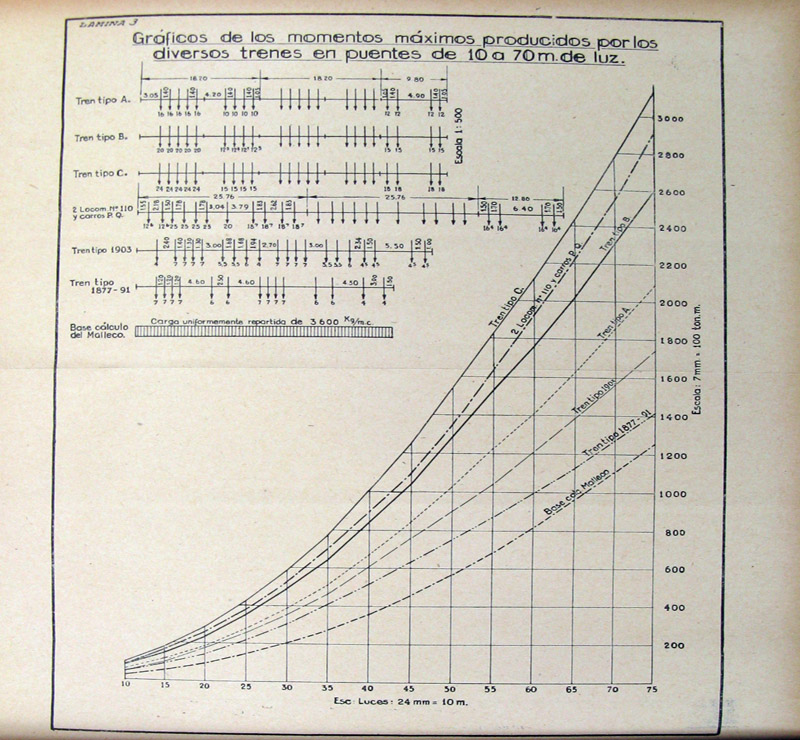
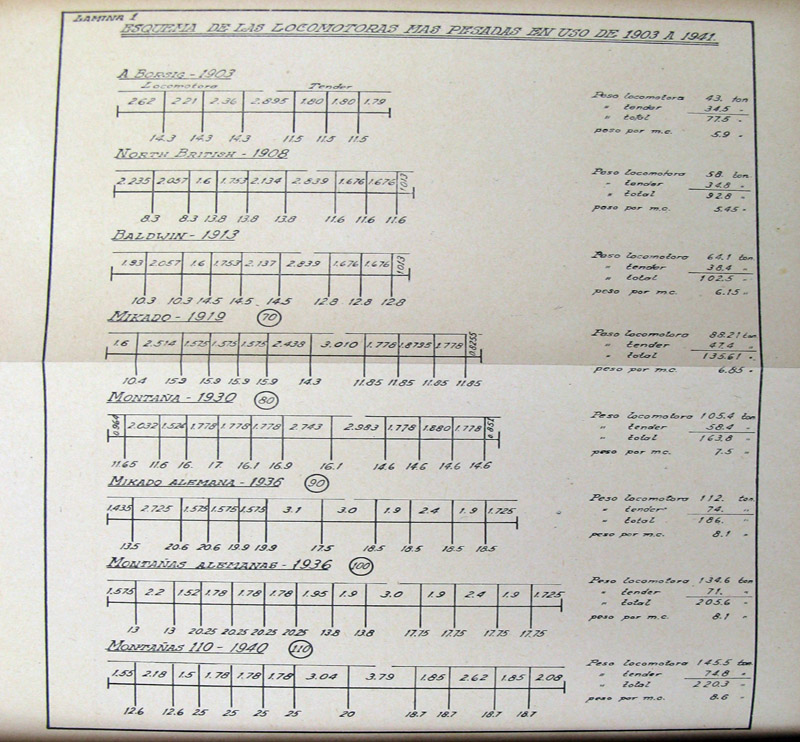
For interest above is a table showing the weight distribution of the heaviest locomotives as introduced between 1903 and 1941.
A requirement of the strengthening was that the work was to be carried out without the necessity for lengthy closures of the line. Thus it would not be possible to improve the strength of a bridge by removing and replacing specific elements in it; strengthening had to be by means of additional elements with limited attachment to the existing structure so that it could be carried out within the period of conventional limited possessions of the line. Schemes involving the removal of rivets and their replacement with bolts to allow rapid dismantling of trusses followedby their reassembling with heavier material were avoided, as the increased clearances in the holes required by bolts would allow distortions to take place.
In 2015 the question of bridge carrying capacity had again come into the frame and a contract was let to inspect all the country's bridges with a view to allowing trains, double headed by type C+ locomotives, each of 250 tons, followed by a train of wagons of 100 tons gross over 9.8 m length (The 1908 Decree allowed only 48-tonne wagons of this length!).
All EFE's bridges of 11 m span and over were to have modern record drawings prepared, inspected to determine repairs necessary, assessed to determine their current loading capacity, and strengthening works designed to bring their capacity up to train headed by two Chilean type C+ 250-ton, 10-axle locomotives. Interestingly this project extended to the terminus at La Paloma (Puerto Montt), though there was the provision for EFE to define a lesser loading on specific sections.
The first bridges listed in our area is the one over the río Quillén, which is about 40 m from bank to bank, but in a deep wide valley.
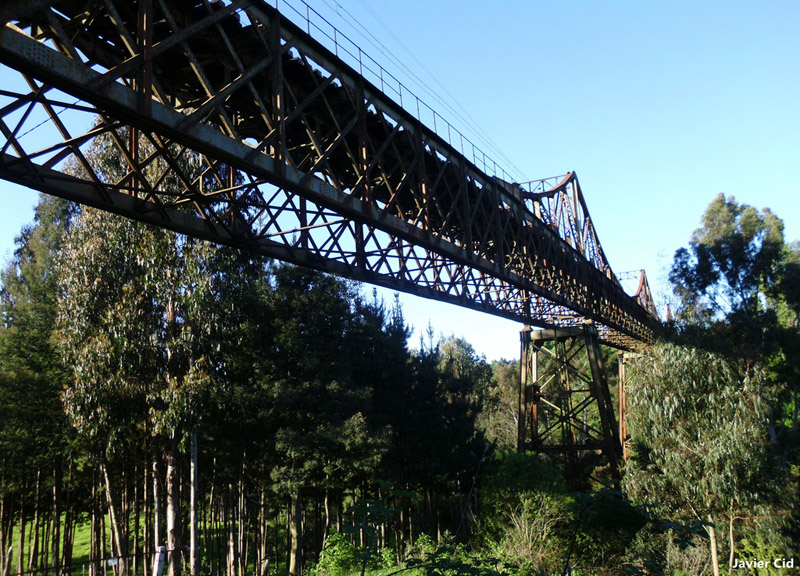
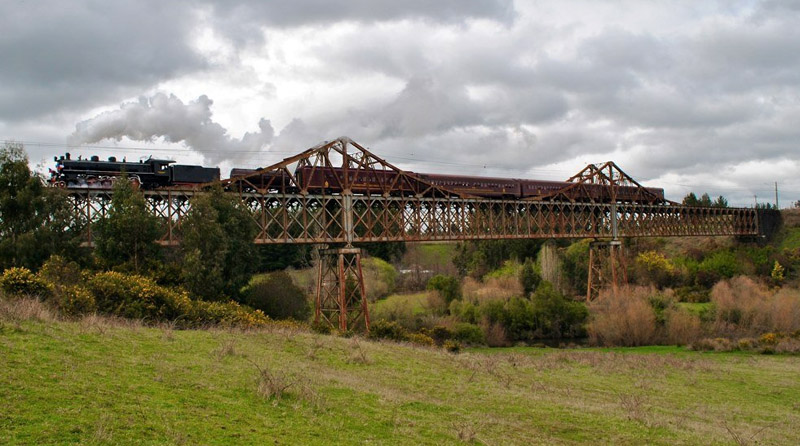
It is of three spans of trusses, whose form is found on other bridges farther south, but it does differ from the others that its two piers are metal structures. According to Gustave Verniory in his book Diez Años en Auracaría the overall length of the bridge is 210 m; as all three trusses are of the same depth, the assumption can be made that each span is of 70 m.
The next bridge identified is that over the río Cautín just to the south of Temuco. Because of its length there are no views of it in its entirety.
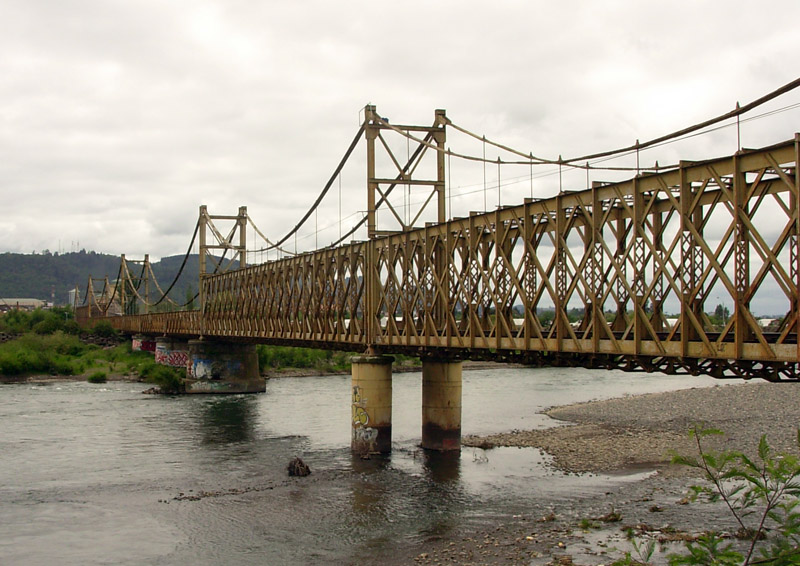
Here we see three short spans (where the train runs between the girders) and two long spans (where the train runs within the girders) over the main channel of the river. The bright yellow paintwork was applied to this and the other railway bridges in the areas from about 2010 on. The bridge carries overhead wires.
The bridge, in this case, has been strengthened by the provision of a light catenary and thin suspension rods.
The form of construction of the piers is generally of mass concrete supporting the bearings. Some of the girders are continuous over the pier.
In the middle of the river channel the pier is formed of two, probably, wrought iron cylinders sunk to a suitable stratum and then filled with concrete.
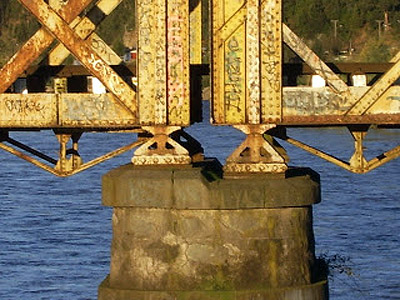
With rather less news coverage than that of the collapse of the Toltén bridge (see further down), the Cautín bridge collapsed on 27 June 2018, also due to the scouring out of one of intermediate piers. (1) [2506A]
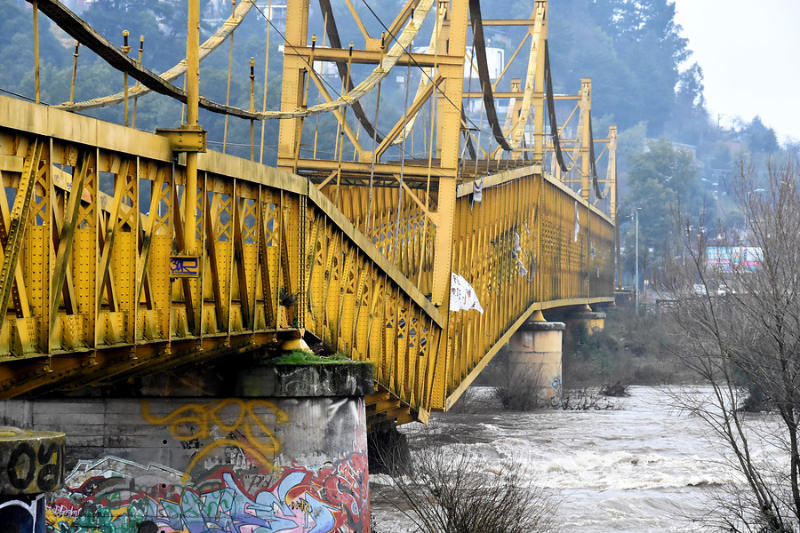
We must confess when this news came through that the first reaction was that would be the end of the railway south of that point. However our expectations were soon proved wrong with the announcement of the intention to rebuild followed by action.
Here is a view of the new bridge with a goods train passing over it. Note how there is a wagon between the two locomotives in order to distribute the loading on long span bridges. Note also the use of decorative suspended arcs on the handrails to remind one of the silhouette of the original bridge. (2) [2505D]
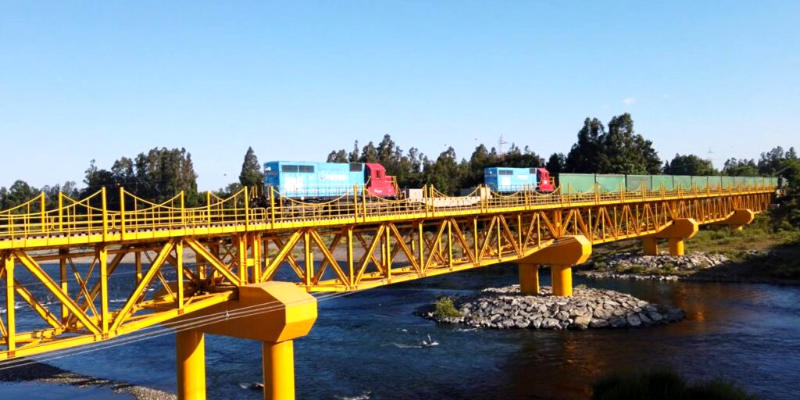
The next bridge going south is that over the río Quepe which would appear now to be called río Vilcún.
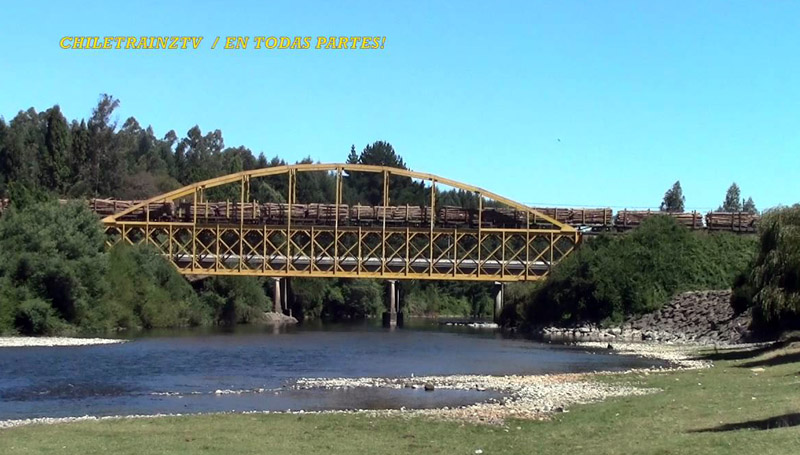
The railway gets over the river in a single jump here. The original girder has been strengthened by the provision of an arch and suspension rods. In this case the form of truss is different from the previous, but similar to that at río Toltén. The train travels on top of the original girders.
Several of these bridges now have a parallel road bridge, perhaps an indication that the route selection for the railway was so good that it couldn't be bettered for the road. In some cases there is yet another road bridge carrying the Pan-American Highway.
The next bridge in the series is the one over the río Toltén on the north side of Pitrufquén. It came into world news on 18 August 2016 when the pier in the main course of the river collapsed bringing down the spans it supported and a third one. A goods train was passing at the time, but fortunately the front part of the train had passed over before the collapse and so there were no injuries.
Currently (August 2016) there is no news as to why the bridge collapsed and whether it will be rebuilt to allow the railway to operate south of this point. These has been some speculation that in recent years there have been illegal works carried out in recent years which altered the river's regime resulting in scour at the collapsed pier
It is made up of nine spans with piers at 50 m centres supported on piers constructed the same way as the river ones of the Cautín bridge. The five piers within the river channel were sunk using compressed air.
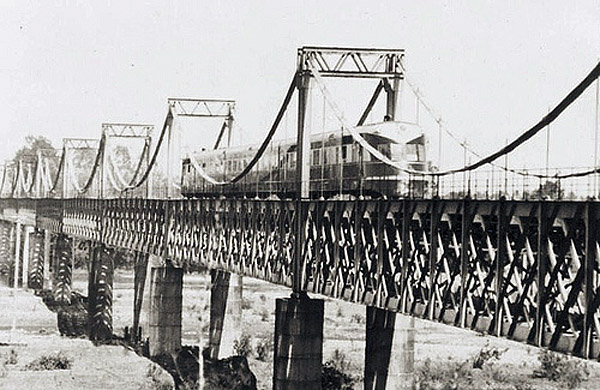
The first view shows a Flecha de Sur express crossing the bridge.
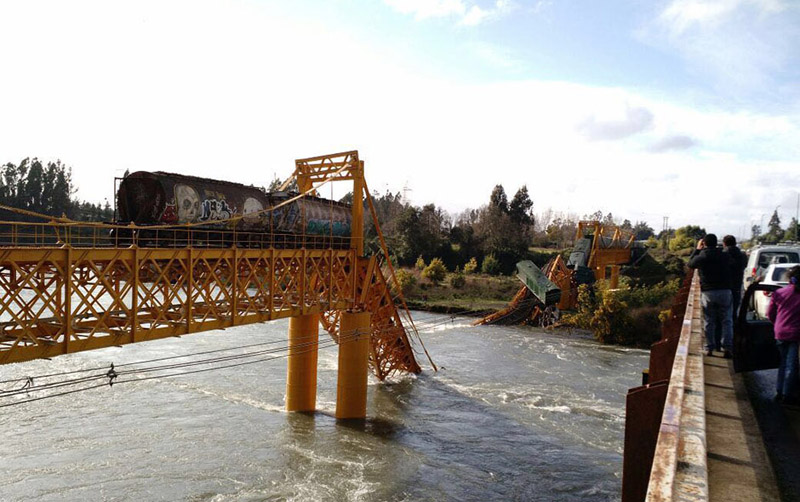
While the second, looking north, shows the three collapsed spans and the absence of the pier in mid-stream.
Continuing southwards the next big bridge is over the río Calle-Calle on which sits Valdivia.
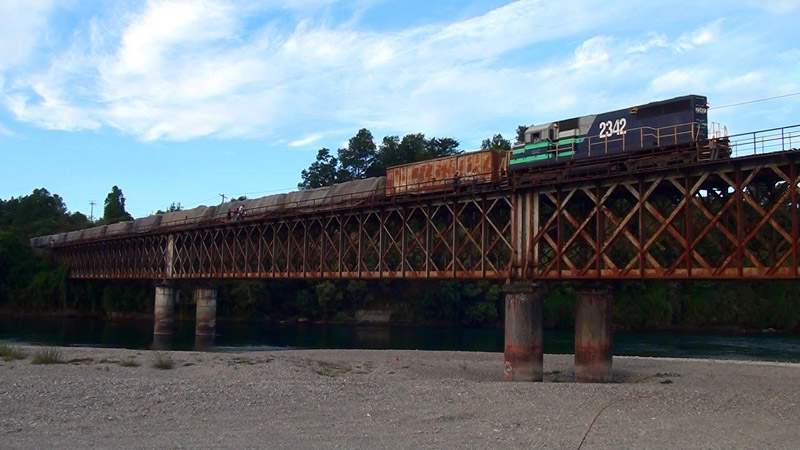
This bridge has a similar looking truss to the one over the río Toltén, but has not been subject to strengthening. As the two bridges were built at different times it may be that the design loading had changed, so strengthening has not been necessary.
Next in line is the bridge over the río Bueno. This is a three-span bridge with an overall length of about 110 m. The piers in the much smaller river are of the same twin cylinder style. Again there has been bridge strengthening.
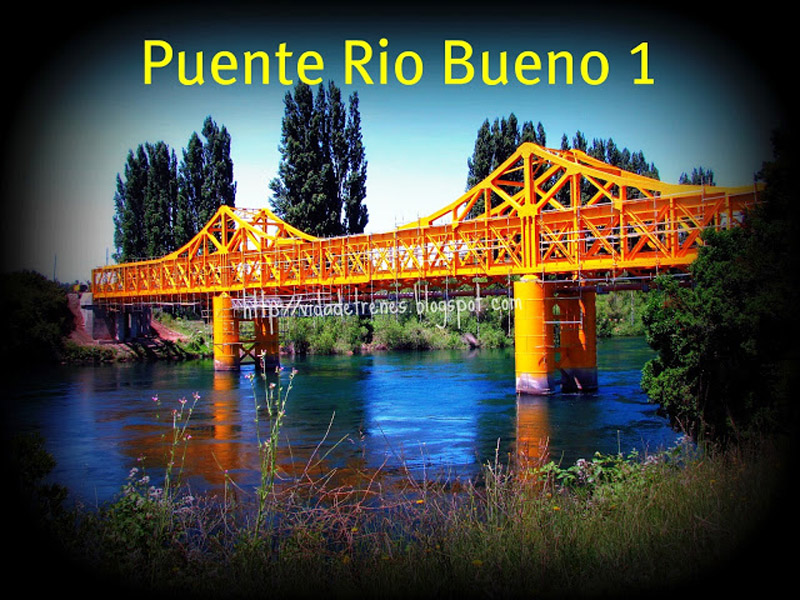
The view is taken from the Vida de Trenes blog which includes a series of pictures showing the painting work in progress. Helpfully there is a notice board pictured which shows that this was one of nine bridges repainted in the area during the period May 2011 to February 2012 by the contractor COMSA (a major contractor based in Spain).
The next bridge for which pictures are available on the web is the one over the río Maullín.
This is a two-span with through trusses and does not appear to have been subject to strengthening.
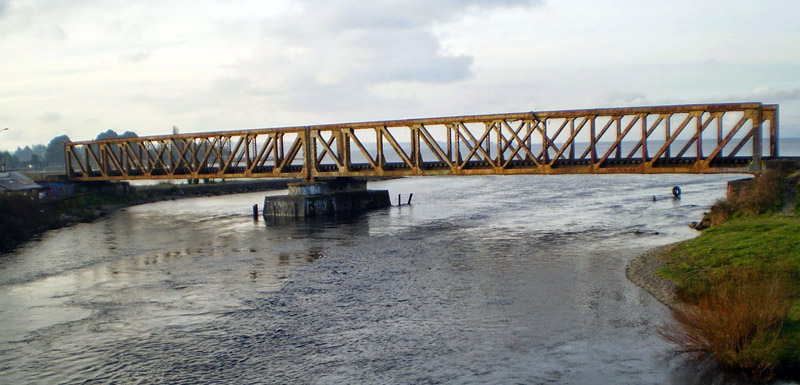
("Refuerzo de Puentes Metálicos en los FF.CC. del E. (Chile)", por Julio Tapia Cabezas, ingeniero civil, jefe de cálculo de puentes de los FF.CC. del E. (Chile), Santiago de Chile, Talleres Gráficos de los Ferrocarriles del Estado, 1945).
Source:
1 Radios Regionales, 12/2/21, on line.
2 Red Medios, 12/2/21, on line.
18-3-2021